
Poco F2 Pro review: Gourmet performance, buffet price
Have your cake and eat it, too
by Myriam JoireAlmost exactly two years ago, Xiaomi pulled a page from OnePlus’ playbook and stunned everyone with the Poco F1 (or Pocophone F1), a phone with proper flagship specs that cost just $300. While the F1 cut some corners to achieve this feat (plastic build, no NFC), it still delivered amazing performance and battery life. Then in 2019, it was followed up by… crickets?
While Redmi’s excellent K20 Pro was technically the Poco F1’s successor, Xiaomi didn’t release a Poco-branded device last year. That changed back in February 2020, when the company announced it was spinning Poco off as a sub-brand. It then re-released Redmi’s K30 Pro as the $500 Poco F2 Pro, and also launched the mid-range Poco X2, M2 Pro, and X3 NFC.
This time around, the Poco F2 Pro is an aluminum and glass sandwich with a Snapdragon 865, 5G (no US support, though), NFC, a notch-less OLED screen, and quad-rear cameras. As you’d expect, there’s a lot to like here. It obviously nails performance and battery life, and even retains the headphone jack. But that display is stuck at 60Hz, and the main shooter lacks OIS — two missing features that are quickly becoming critical in the highly competitive sub-$500 premium mid-range segment. Then, there’s MIUI 12. While Xiaomi’s Android skin has improved somewhat since the Poco F1, it’s still far from the clean user experience offered by Google, OnePlus, Moto, or Nokia. I’m not a fan.
Finally, $500 for a Poco F2 Pro today is a lot more money than $300 was for the Poco F1 two years ago. For that kind of cash, do you go for specs above all and sacrifice some features, or do you settle for a phone with a Snapdragon 765G that’s more balanced, like the OnePlus Nord? Gamers might prefer the F2 Pro, but having used both phones for a few weeks, I think most folks will be happier with the Nord.
Specs
| SoC | Snapdragon 865 |
| RAM | 6/8GB (LPDDR4X/LPDDR5) |
| Storage | 128/256GB (UFS 3.1) |
| Display | 6.67-inch 1080 x 2400 AMOLED, 60Hz, 20:9, HDR10+ |
| Battery | 4700mAh |
| Camera | 64 MP, f/1.9, PDAF, no OIS (wide); 13 MP, f/2.4, 123˚ (ultrawide); 5 MP, f/2.2, AF (macro); 2 MP, f/2.4 (depth); 20MP f/2.2 (selfie) |
| Software | MIUI 12 on Android 10 |
| Connectivity | Wi-Fi 802.11 a/b/g/n/ac/6, Bluetooth 5.1, LTE (no 5G in the US) |
| Measurements | 163.3 x 75.4 x 8.9 mm, 219 g |
| Price | approx $400 |
The Good
| Battery life | This phone is like the Energizer bunny. It just keeps on going, and going, and going. |
| Performance | That Snapdragon 865 delivers all the speed, all the time. It’s always quick. |
| Value | Buy it for the sub-$500 price or buy it for the specs? Yes. Have your cake and eat it, too. |
| Display | This AMOLED screen is flat, and devoid of annoying notches or punch holes. |
| Design | Aluminum and glass build, fun colors, cool motorized pop-up selfie camera. |
The Not So Good
| Cameras | Promising specs on paper, middling performance in practice. No OIS. |
| Display, again | It’s a fine AMOLED screen, but what happened to that 90 or 120Hz refresh rate? |
| Speaker | It exists, it makes sounds, it fails to impress. At least there’s a headphone jack. |
| No US 5G | Despite using a Snapdragon 865 and being a global handset, there’s no US 5G support (granted, this is mostly because our carriers suck, i.e. not Poco's fault). |
| MIUI 12 | Xiaomi’s skin is more cohesive and much smoother, but still too heavy handed. |
Design, hardware, what's in the box
The Poco F2 Pro looks and feels a lot more premium than the plastic-clad Poco F1 did, thanks to a glass and aluminum build. Branding aside, this phone is identical to Redmi’s K30 Pro — even down to the choice of lustrous colors. My review unit came in a deeply reflective shade called Neon Blue that’s a complete fingerprint magnet. Other hues include Phantom White, Electric Purple, and Cyber Gray.
In a nod to flagships past, the F2 Pro packs a motorized pop-up 20MP selfie camera, so there’s no notch or hole punch to interrupt the screen. Then again, there’s no official water and dust protection, although I noticed a gasket around the SIM tray. In back is a large, black, round camera pod reminiscent of the Huawei Mate 30 Pro’s that contains four shooters (64MP main, 13MP ultrawide, 5MP macro, and 2MP depth). There’s also a triple-LED flash.














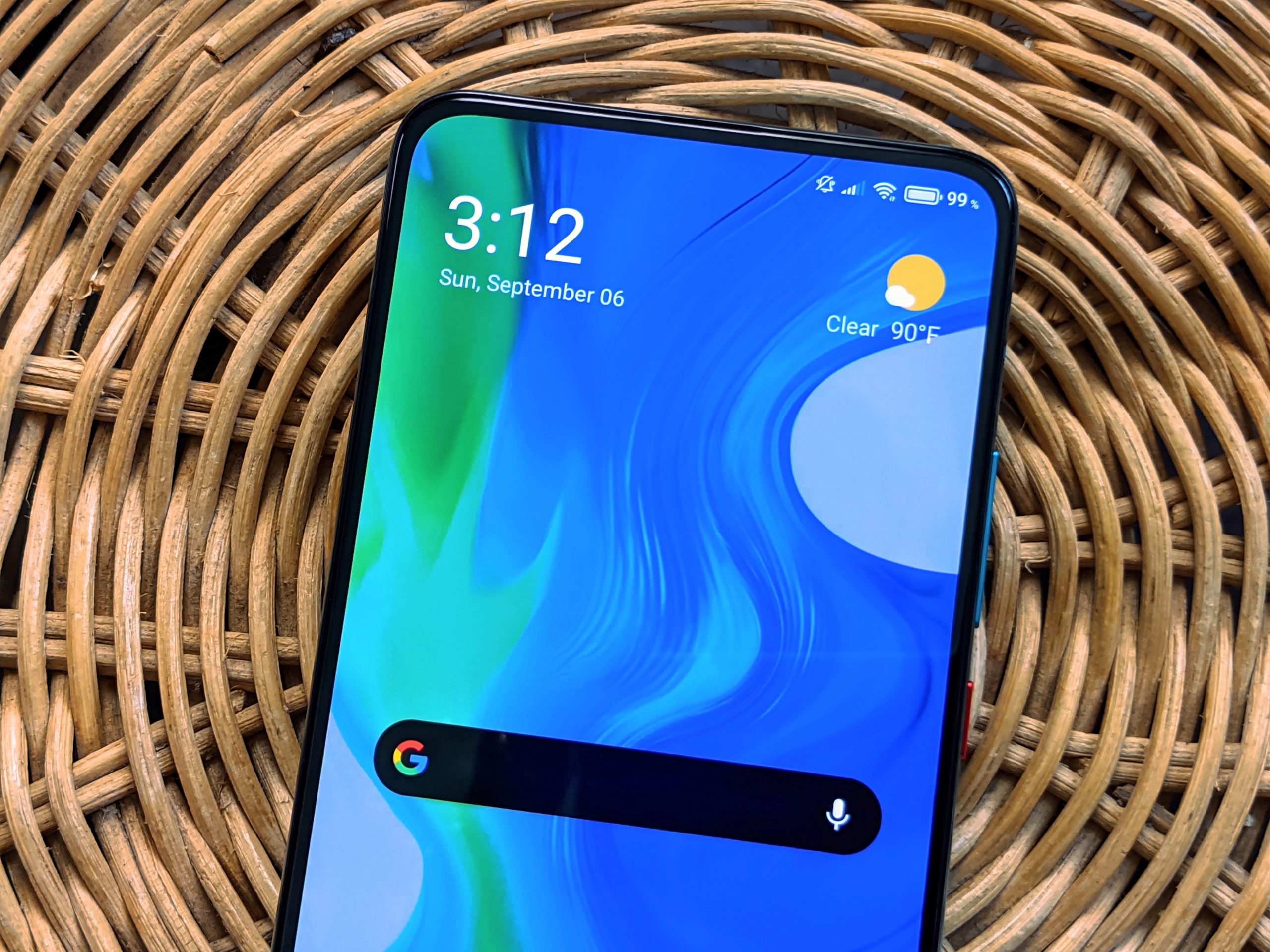



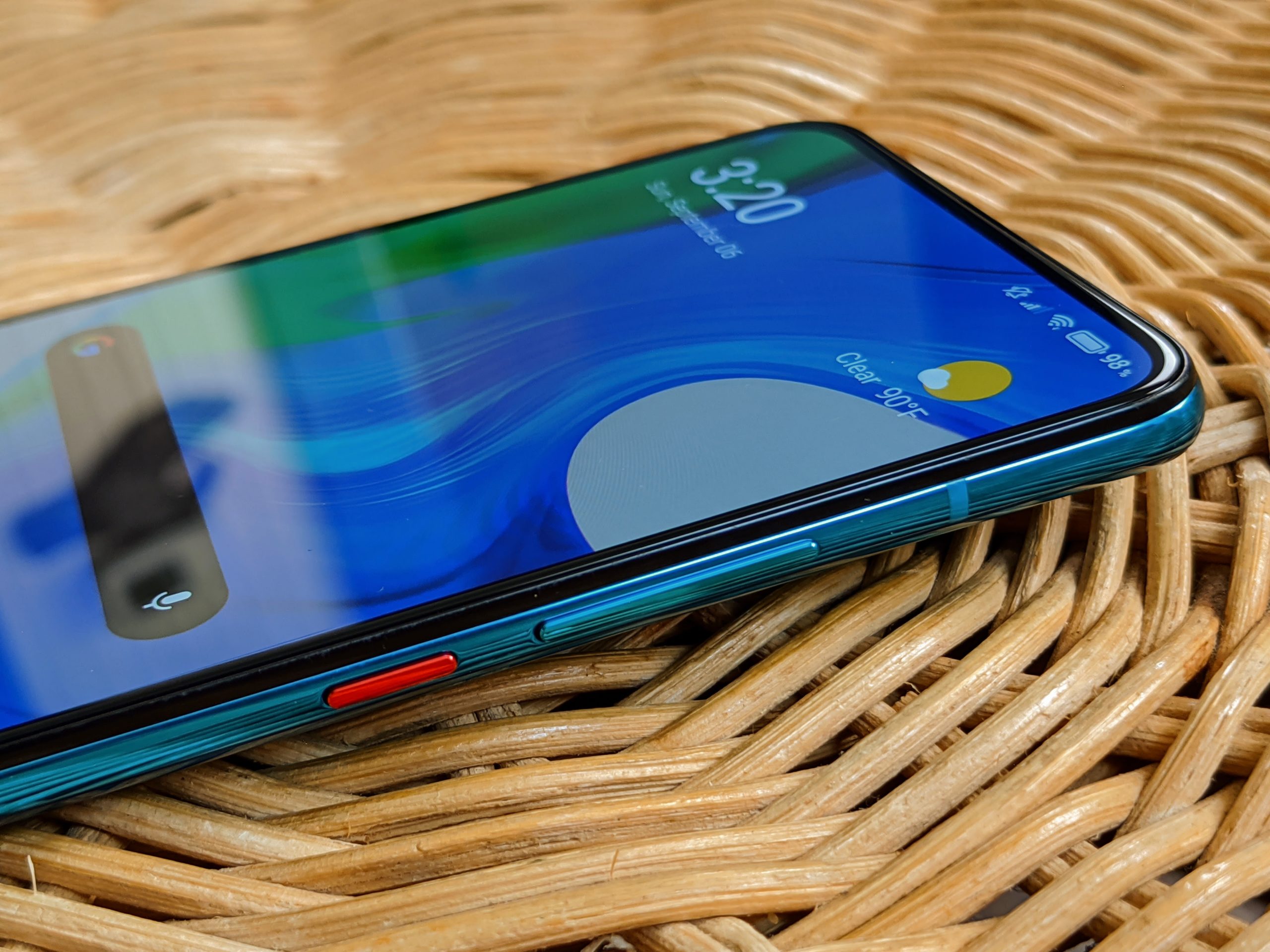



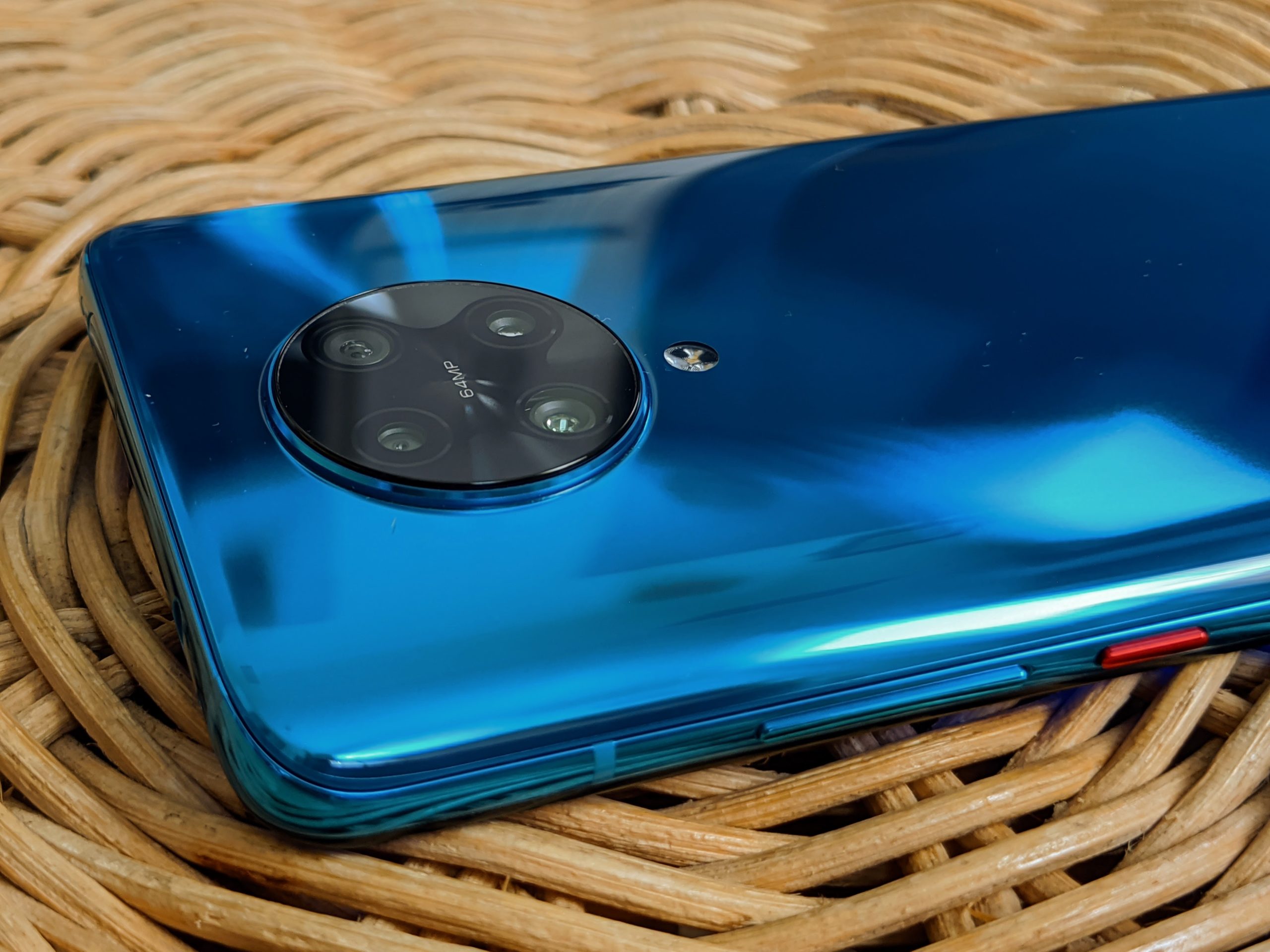
Clocking in at 163.3 x 75.4 x 8.9mm and 219g, the F2 Pro is a big phone with a big 6.67-inch display and a big 4700mAh battery. In fact, it’s almost the same size and weight as Samsung’s Galaxy S20 Ultra — minus the massive camera bump, naturally. This is deceiving, because the F2 Pro doesn’t look as large as the S20 Ultra. Pick it up, though, and it immediately feels quite substantial.
The F2 Pro features a 6.67-inch FHD+ (2400 x 1080 pixels, 395ppi) AMOLED screen with a 20:9 aspect ratio and HDR10+ support. As I previously mentioned, there are no notches or punch holes getting in the way of content here. Bezels are small all around, with the chin being slightly larger, and the forehead being home to the earpiece. An optical in-display fingerprint sensor completes the package.

It’s a nice screen overall, with punchy colors, deep blacks, and decent viewing angles. Brightness could be better in direct sunlight, but I’m nitpicking (nit — get it?). What’s somewhat disappointing, though, is the F2 Pro’s lowly 60Hz refresh rate. It’s a surprising omission since the cheaper Poco X2 (aka. Redmi K30) boasts a 120Hz panel. The fingerprint sensor could be faster, too — at least it’s reliable.
Haptics are adequate. I doubt Xiaomi’s using a linear vibration motor here — it’s strong enough but feels cheap. The motorized selfie camera performs a cool light show each time it pops up and down — complete with matching on-screen animations and (defeatable) sound effects — thanks to a pair of RGB LEDs located on either side of the front shooter. It’s exactly the same setup as on last year’s Redmi K20 Pro.

These RGB LEDs turn into a single notification light when the selfie camera is stowed, so that’s pretty cool. Besides the pop-up front shooter, you’ll find an IR blaster (!), headphone jack, and secondary mic on the top edge of the F2 Pro. The bottom edge is home to the mono speaker, primary mic, USB Type-C port, and dual SIM tray (there’s no microSD card support). Don’t expect much from that mono speaker: it doesn’t sound very good.
Looking along the sides, there’s a nifty red power/lock key and a volume rocker on the right, but absolutely nothing on the left. The F2 Pro doesn’t offer wireless charging, but supports up to 33W wired fast charging and is compatible with USB PD 3.0 and Quick Charge 4+. In the box, Xiaomi includes a proprietary 33W fast charger and matching USB Type-A to C cable, plus a clear, flexible TPU case.
Software, performance, and battery
The Poco F2 Pro runs Xiaomi’s latest MIUI 12 skin on top of Android 10. Honestly, it’s still a kind of a mess. And before you get mad, this isn’t my first rodeo. I review a lot of phones destined to markets outside of North America — handsets for Europe, India, and Asia. I’m quite familiar with the various skins used by Chinese manufacturers. They’re all slowly moving away from poorly copying iOS to embracing the Android way.
Also, while I much prefer a stock Android experience, I’m not a die hard purist. I can live with Samsung’s One UI, for example. I also think Oppo’s Color OS 7 and Huawei’s EMUI 10 are big improvements over previous versions, and it’s the same with MIUI 12. So I recognize Xiaomi’s progress here — especially in terms of design (more cohesive) and performance (much smoother). But I want even more.
Why is the settings menu so disorganized? It’s as if Xiaomi randomized the order of every item in Android’s standard settings menu, just for fun. The recent apps screen is cluttered, and you have to swipe sideways to minimize apps, instead of swiping up. And most annoyingly, you can only dismiss notifications by swiping right. You can’t swipe left to remove them — except on the lock screen, where notifications behave as expected. WTF?

On the plus side, the Poco’s launcher features an app drawer that scrolls vertically (i.e. the right way), and you can’t disable it. Google Discover is also right where you want it to be, but can be turned off. I’m not sure why anyone would do that, but hey. And if you’re a real masochist, you can switch to MIUI’s notification shade instead of Android’s, and MIUI’s new iOS-like Control center instead of the standard Quick Settings. But don’t, okay?
As for performance, the F2 Pro is a scorcher. I’m not saying it gets hot; I’m saying it’s blazingly fast — as you’d expect from a phone with Qualcomm’s flagship Snapdragon 865. There are two versions of the F2 Pro: 6GB RAM (LPDDR4X) / 128GB storage, and 8GB RAM (LPDDR5) / 256GB storage. Both use UFS 3.1 for storage, but different RAM, which is interesting. I reviewed the 6/128GB model.
I’m a power user, so I juggle a lot of productivity, messaging, social media, and imaging apps. The F2 Pro never let me down, regardless what I threw at it. It’s going to feel nice and snappy no matter what you’re doing. Sure, it could be even smoother, but I think that’s down to the 60Hz display. My main phone is a OnePlus 8 Pro, so I’m used to that sweet 120Hz refresh rate. Overall, I have zero complaints here.
Since I’m not much of a gamer, I didn’t really stress graphics performance. But based on my experience reviewing a number of Snapdragon 865-equipped handsets over the last few months, I’m sure gaming enthusiasts will be just fine. And while I didn’t have any issues running out of memory, 6GB seems a bit low considering the rest of the specs, so I’d probably buy the 8/256GB model with the faster RAM.
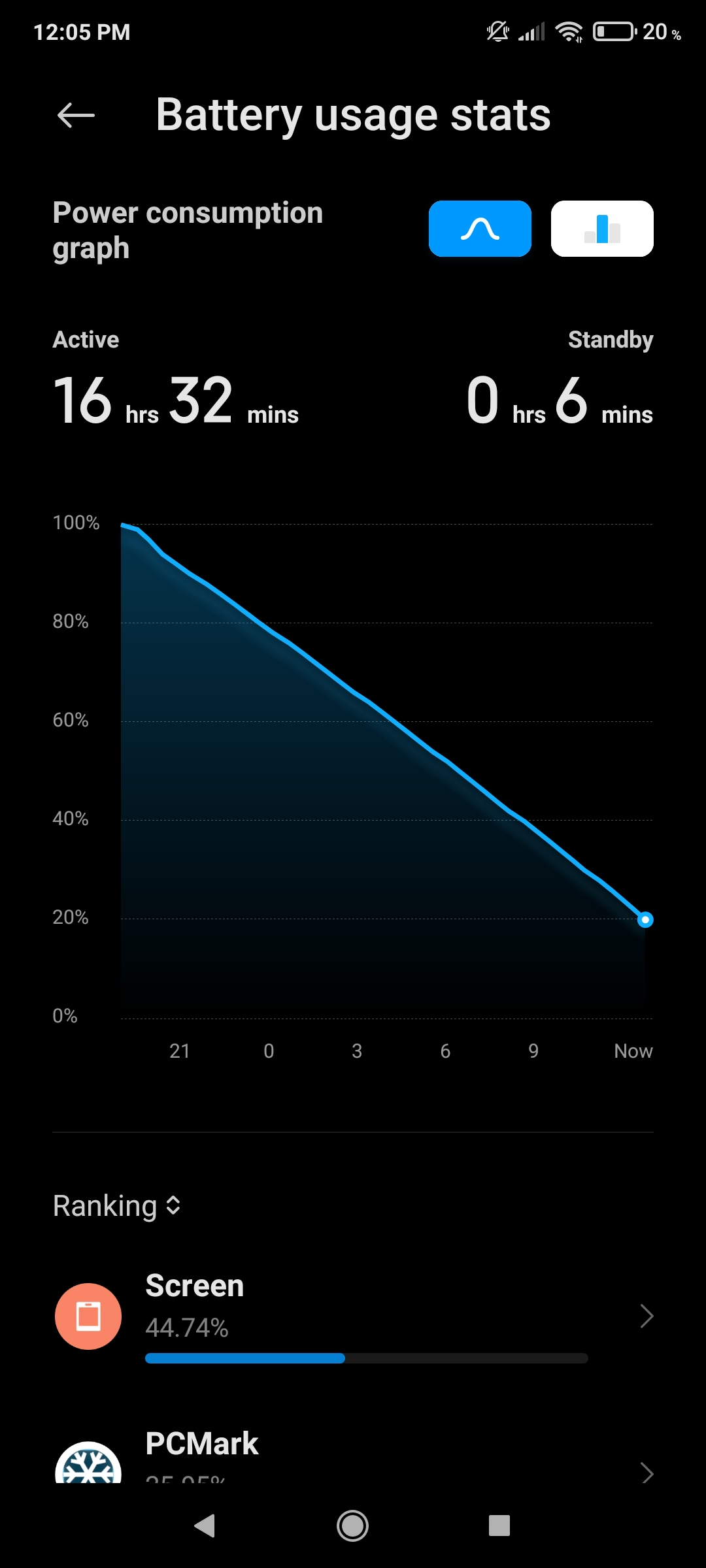
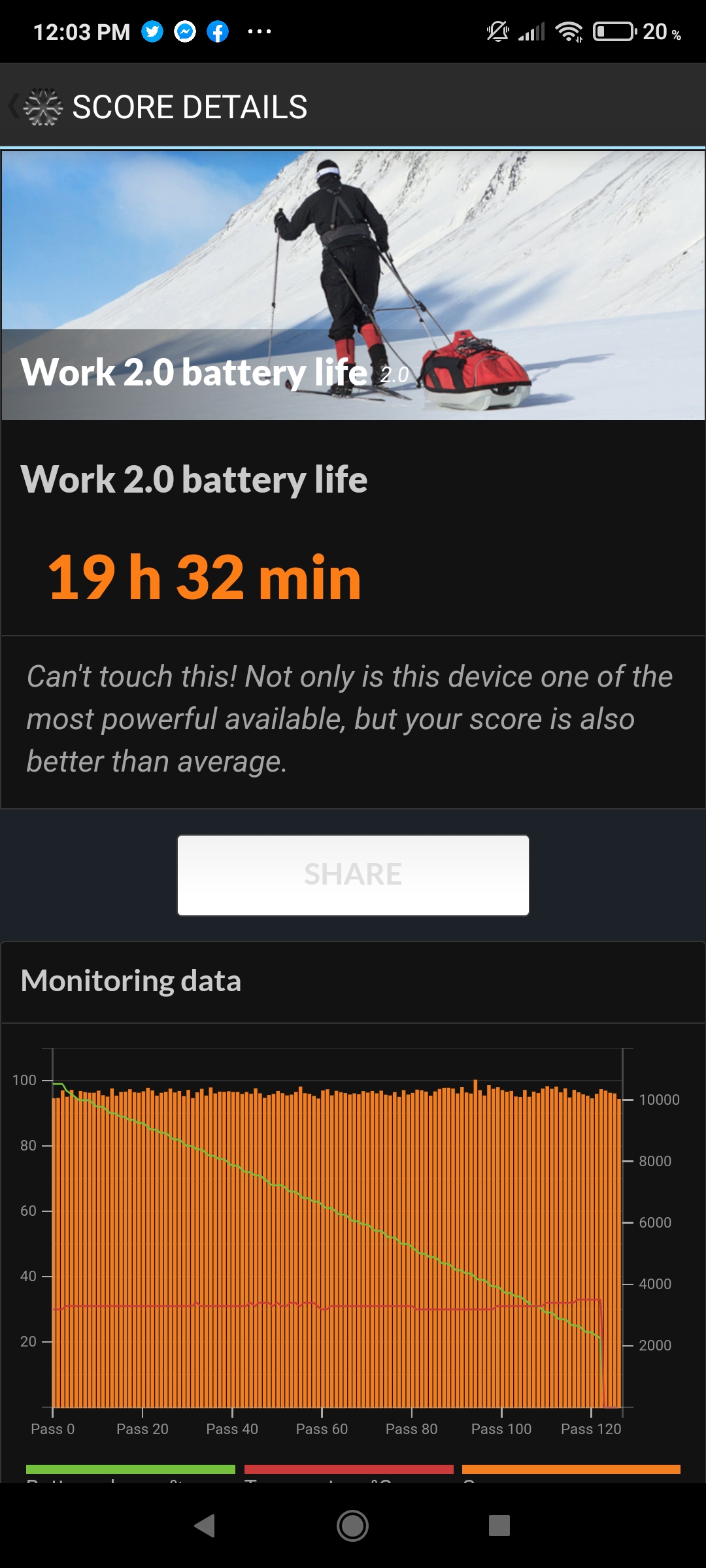
Battery life is phenomenal, thanks to the F2 Pro’s large 4700mAh battery, that 60Hz-only screen, and MIUI’s assertive memory management. I typically saw well over 10 hours of screen-on time per charge. Basically, most folks will have no problem using the F2 Pro for a couple days before needing to plug in. And when it’s time for a refill, it takes just over an hour from 0-100% thanks to that 33W fast charger.
Unfortunately, the F2 Pro lacks 5G bands for the US. With my AT&T SIM installed, the phone recognized AT&T’s sub-6GHz network (n5, 850MHz) and showed the 5G icon, but only ever connected via LTE. This is pretty common behavior for 5G phones that lack the right bands, so I just turned off 5G. Strangely, the 5G icon didn’t even appear with my T-Mobile SIM, despite San Francisco having sub-6GHz 5G coverage (n71, 600MHz).
Cameras
The Poco F2 Pro packs four shooters in the back, and a motorized pop-up selfie camera. It includes a 64MP f/1.9 0.8-micron Sony IMX 686 main shooter without OIS, a 13MP f/2.4 1.12-micron 123-degree ultrawide, a 5MP f/2.2 1.12-micron macro with AF, and a 2MP f/2.4 1.75-micron depth sensor. Selfies are handled by a 20MP f/2.2 0.8-micron lens. These are decent specs on paper, other than the lack of OIS.

Like other 64MP Quad Bayer sensors, the Sony IMX 686 actually outputs 16MP by “binning” (combining) clusters of 4 pixels into larger 1.6-micron pixels for better low light performance. There’s a full 64MP mode if you need to capture more detail, but it requires decent light for best results. I was hoping the 20MP selfie camera might also use pixel-binning to capture 5MP images in low light, but that’s not the case.
Poco’s camera app is pretty standard, and reasonably intuitive. For stills, the F2 Pro features the usual shooting modes, including portrait, pro (manual), night, and panorama. Unfortunately, the night and pro modes only work with the main shooter. I was hoping the night mode would be available on the ultrawide and selfie cameras too, but nope. Then again, you can shoot panoramas with the “front” shooter. Cool, I guess?
































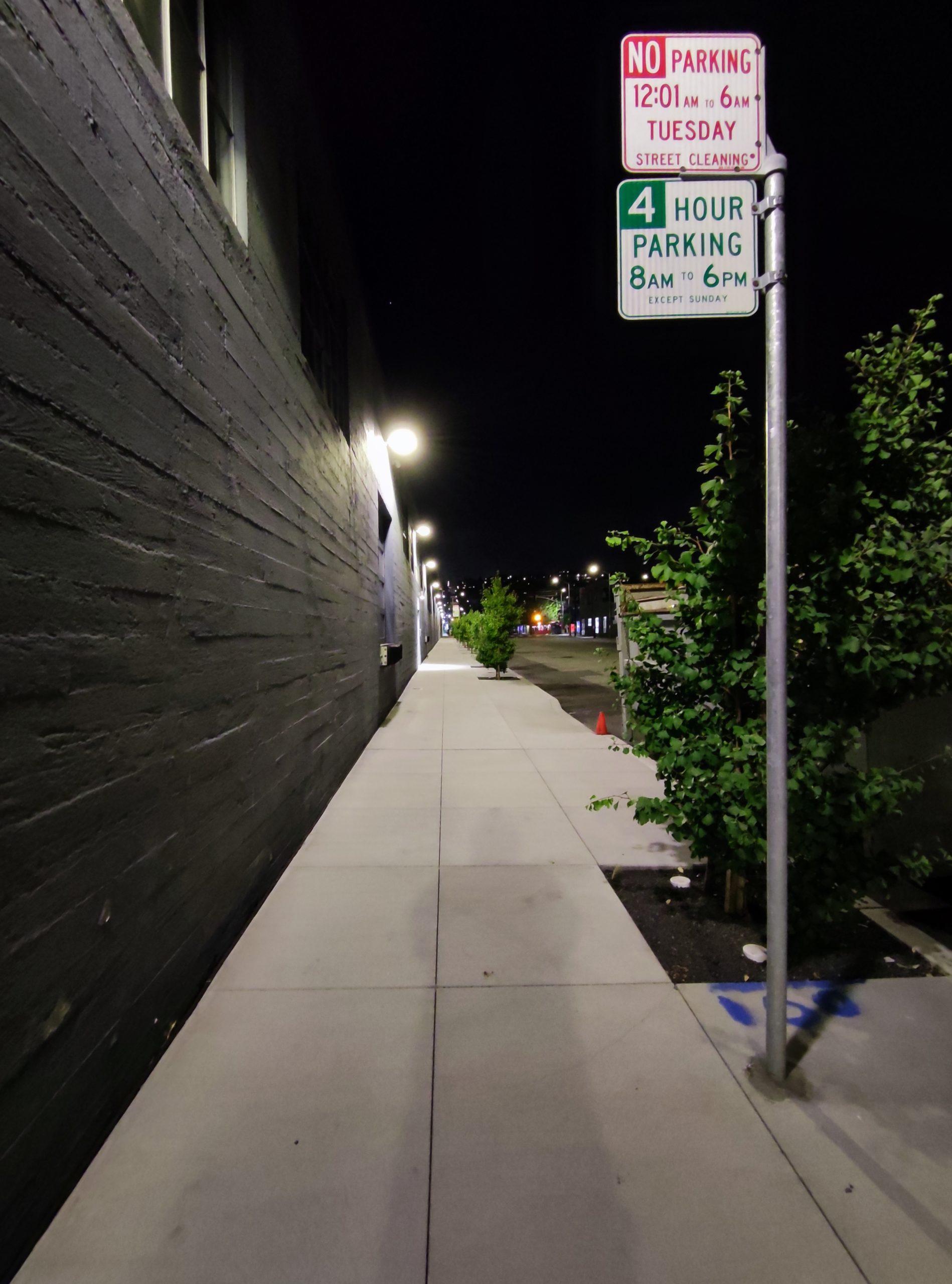





When it comes to video recording, the F2 Pro supports up to 8k 30fps, 4k 60fps, and 1080p 60fps with the main shooter (6x zoom maximum). The ultrawide tops out at 4k 30fps or 1080p 60fps, while the macro and selfie cameras max out at 1080p 30fps — all stabilized. Audio is captured in stereo, and video modes include ultra steady (1080p 30fps only), slow motion (up to 1080p 960fps), and time lapse (up to 4k 30fps).
The resulting photos and videos are generally fine, but not flagship-worthy. Night mode doesn’t really do much other than improve dynamic range slightly, and the lack of OIS really hinders low-light performance. Zooming is acceptable up to 2-3x, but anything beyond that quickly turns images into oil paintings. AF on the macro lens is nice to have, but I’d much prefer a dedicated telephoto. At least the selfie camera takes enjoyable portraits.


Ultimately, the F2 Pro’s camera system doesn’t live up to the rest of the phone. And frankly, that’s odd considering Sony’s IMX 686 is a decent sensor. I also know Xiaomi can do much better after recently spending time with the company’s Mi 10. Premium mid-range handsets like the OnePlus Nord offer better imaging at this price point — not to mention everyone’s favorite, Google’s $349 Pixel 4a.
Should you buy it?
Poco F2 Pro
8/10
Probably, yes. If you value performance and specs above all, play a lot of graphically demanding games, don’t mind its middling cameras, and don’t need 5G (here in the US), the Poco F2 Pro offers fantastic value. I suggest you pony up the extra $100 for the 8/256GB version, though. With the 6/128GB model currently selling for less than $500 (as low as $400), you’re getting an incredible deal no matter which one you choose.

I like the F2 Pro’s refined design, beautiful display, snappy performance, and outstanding battery life — not to mention that unbeatable value. MIUI 12 isn’t really my bag, but I can live with it, and your mileage will vary. For me, imaging is where the F2 Pro stumbles. I was expecting more from a Sony IMX 686 paired with a Snapdragon 865. Still, I think most people will be happy with these cameras.
If you’re a hardcore gamer first and foremost, need a high refresh-rate display, or want 5G in the US, consider the Nubia RedMagic 5S ($579). Conversely, if specs matter less, you’ll probably be better served by a Snapdragon 765G-based handset like the OnePlus Nord (abroad) or Google’s upcoming Pixel 4a 5G (in the US). Me? I’ll take a more rounded device over one with maximum performance every time.
Buy it if...
- You value performance and specs above all
- You play a lot of graphically intensive games
- You want the best bang for your buck
Don’t buy it if...
- You expect flagship-worthy cameras
- You need a high refresh-rate screen
- You want 5G in the US